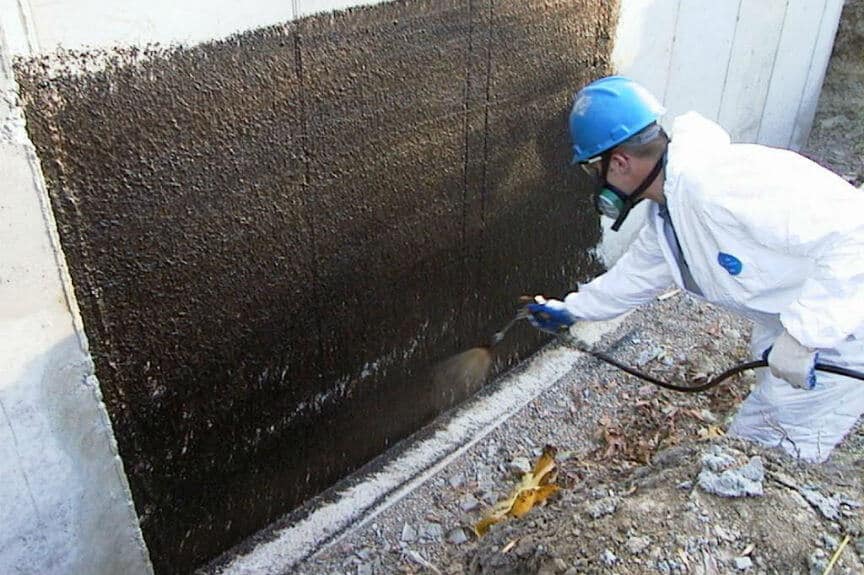Giovanni Valle is a licensed architect and LEED-accredited professional and is certified by the National Council of Architectural Registration Boards (NCARB). He is the author and managing editor of various digital publications, including BuilderSpace, Your Own Architect, and Interiors Place.
Building foundations are in constant contact with the earth and as a result, are regularly subjected to moisture from groundwater. This can be problematic in areas with high water tables or where soils drain poorly.
To prevent structural damage, damp proofing and waterproofing are commonly used in building construction, particularly for basement and foundation walls where it is most critical.
Both damp proofing and waterproofing prevent moisture penetration. The primary difference between the two is that waterproofing can withstand hydrostatic pressure in addition to moisture control. Damp proofing, on the other hand, is not an effective barrier for water under pressure.
Damp proofing does, however, effectively stop diffuse ground moisture from coming through a wall. When applied in relatively dry locations, it can be sufficient to avoid moisture penetration.
It’s also important to note that joints in foundation walls are also prone to water infiltration and must be protected. This is typically achieved through the use of waterstops, which we will also cover.
Damp Proofing
For surfaces not subjected to hydrostatic gravity or air pressure differences waterproofing can be a light duty coating. This provides a moisture-resistant membrane that damp proofs the assembly.
Most damp proofing treatments are applied in liquid form by brushing, rolling, or spraying to the earth contacting surfaces of foundation or basement walls.
These treatments include asphalt base coatings, usually applied in two coats, cement plaster, which is densely mixed and troweled or pneumatically applied, and liquid silicones or other plastics.
Damp proofing also involves preventive measures such as draining surface water away from a building, providing granular fill under a concrete slab on grade and employing footing drawings to carry groundwater away from the structure.
Waterproofing
Waterproof membranes are applied to foundations in situations where damp proofing and drainage are not sufficient to provide protection. They are also necessary for soil conditions under hydrostatic pressure.
The most common method of waterproofing subsurface walls is through the use of membrane waterproofing. Membranes are applied on the earth contacting side of walls so that water pressure will force the membrane against the water-proofed surface.
They are typically made up of several layers of asphalt-saturated felt hot mopped together with tar or asphalt pitch. They are specified as either 2-ply or 3-ply depending on the number of layers used.
In order to protect wall membranes from puncture during backfilling, a coat of cement plaster, a sheet of fiberboard, or a wythe of masonry is commonly used.
When detailing or installing waterproofing, it’s important to provide a continuous barrier of protection. Both horizontal and vertical surfaces should be covered. This includes footings and slabs where moisture penetration can occur.
Waterstops
Because walls and floors below grade usually have joints, waterstops are used to prevent water penetration. Manufactured from non-corrosive metal or various plastics, waterstops permit movement without rupture.
Commonly used materials for waterstops include thermoplastic extrusions such as PVC, thermoset rubber extrusions, hydrophilic bentonite and rubber strips, metallic extrusions and injection hose systems.
Expected lateral, transverse, and shear joint movements and expected hydrostatic pressure need to be taken into account when detailing or selecting waterstops.
Waterstops should be treated as strategic building envelope barrier materials. For waterstops to be effective, they need to be properly designed, installed, and good concreting practices during construction need to be adhered to.
Final Notes
Preventing water infiltration through walls, in particular foundations, is critical to maintaining the integrity of the structure. Over time, moisture can cause damage to the foundation wall and any other materials that come in contact with it.
Moisture also can also encourage the growth of mold and mildew once it penetrates the building envelope. Damp proofing, waterproofing, and waterstops can all effective ways of preventing water damage.
In addition, drainage can serve as a preventive measure to reduce the amount of moisture that foundations and walls are subjected to. It’s important to consider all of the methods discussed holistically and to factor in the geographic location of the site in order to come up with the best possible solution.
Share this Post

